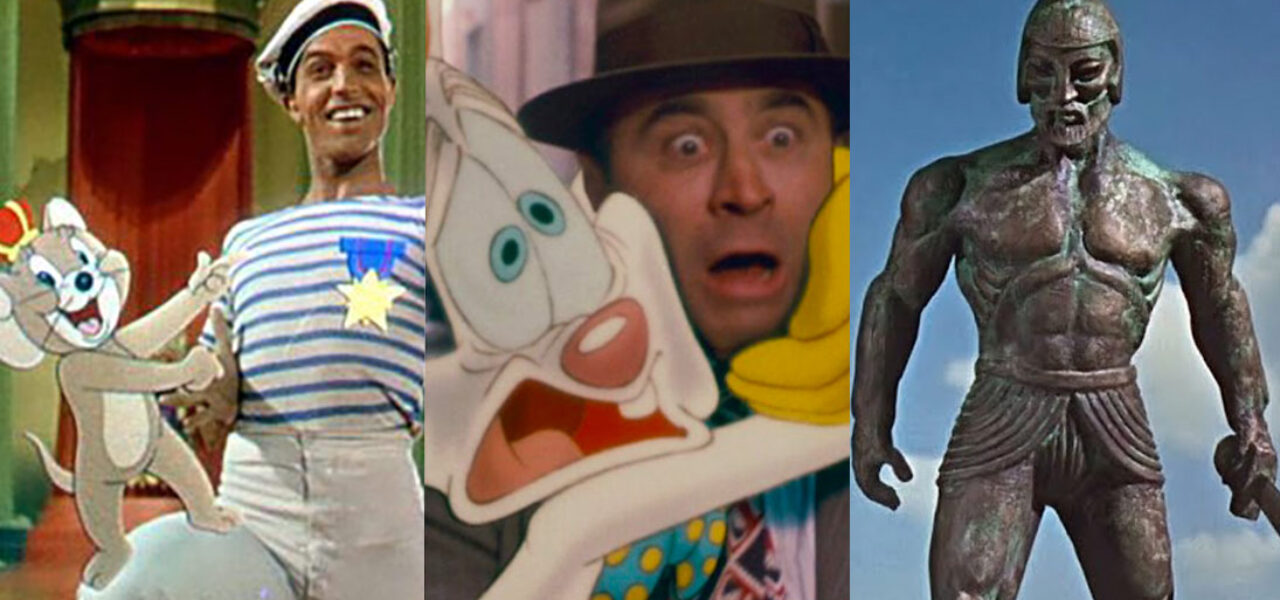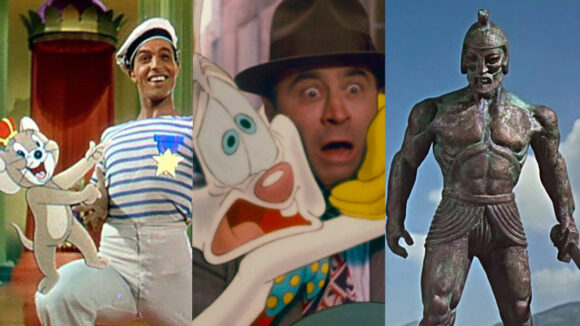

Magical Mash-Ups: A History Of Live-Action/Animation Hybrids
Disney’s new Chip ‘n Dale: Rescue Rangers movie sees various animated characters of different styles and eras coexisting in a live-action Los Angeles. The premise of the film is that Dale is now 3d (having had “cgi surgery”) while Chip remains 2d, but both characters are actually computer-animated; Chip is simply cel-shaded to appear flat.
This got us thinking about the long history of mixing live action and animation in the days before computers. There’s something magical about seeing a hand-drawn cartoon character interacting with people and places from “our world.” Audiences of the 1930s must’ve been delighted to see Mickey Mouse unexpectedly pop up in the MGM film Hollywood Party (1934), alongside oft-parodied comedian Jimmy Durante.
— Cartoon Study (@CartoonStudy) May 20, 2022
Blending animation and live action creates such a spellbinding look that it always feels like a state-of-the-art special effect, but such combinations stretch back to the beginnings of the art form. “Trick films” from the early 1900s incorporated moments of stop motion as a kind of magic trick, with a good example being the hair-brushing scene in Hôtel électrique (1906) by Spanish filmmaker Segundo de Chomón.
— Cartoon Study (@CartoonStudy) May 20, 2022
The mixture of live action and hand-drawn animation was popularized by Max Fleischer’s silent-era Out of the Inkwell cartoons. In these deliciously surreal shorts, star Ko-Ko the Clown would routinely hop off the drawing board and wreak havoc on his hapless creator Max, as in this wild scene from Trip to Mars (1924).
— Cartoon Study (@CartoonStudy) May 20, 2022
The earliest feature film to make extensive use of animated special effects was The Lost World (1925), which boasts stop-motion dinosaurs created by the great Willis O’Brien. Watching it today, the jerky movements are part of the charm, but audiences of the 1920s had never seen anything like this and many were convinced the filmmakers had discovered actual dinosaurs. After Sir Arthur Conan Doyle showed a test reel, the New York Times ran a front-page story that said, “(Conan Doyle’s) monsters of the ancient world, or of the new world which he has discovered in the ether, were extraordinarily lifelike. If fakes, they were masterpieces.”
— Cartoon Study (@CartoonStudy) May 20, 2022
All Hollywood blockbusters of today owe something to King Kong (1933). O’Brien’s effects were complicated on an unprecedented scale, and the movie pioneered the use of the optical printer for compositing shots, so that foreground imagery, live-action footage, stop-motion animation, and backgrounds could be shot on separate strips of film and later combined into a single image. Kong himself was crafted out of a metallic armature and covered with sponge rubber and rabbit fur, but he’s more than just a special effect; O’Brien’s thoughtful animation gives the creature a real personality, and that’s why the film has stood the test of time.
— Cartoon Study (@CartoonStudy) May 20, 2022
As cartoons entered the sound era, the Fleischer studio kept finding new, creative ways to incorporate live action into their cartoons. One of the best uses of the technique is the wonderfully insane ending of the Betty Boop short Ha! Ha! Ha! (1934), where laughing gas seeps out of the cartoon and into the real world. The way the photographed elements seamlessly transition into drawings speaks to the animators’ skillful draftsmanship.
— Cartoon Study (@CartoonStudy) May 20, 2022
Another standout Fleischer scene comes from Adventures of Popeye (1935), in which a live-action boy mimics his cartoon hero. I love the fact that in a Popeye short, even real kids mutter under their breath without opening their mouths.
— Cartoon Study (@CartoonStudy) May 20, 2022
One of the best live action/animated combos is Friz Freleng’s classic Looney Tunes short You Ought to be in Pictures (1940), where Porky Pig throws away his cartoon contract with real-life producer Leon Schlesinger. Despite working on a low budget (the staff only had access to a silent film camera, so voices were dubbed in later), the clever melding of elements is thoroughly effective and endearing.
— Cartoon Study (@CartoonStudy) May 20, 2022
Even hardcore Disney buffs might not be aware of Servants’ Entrance (1934), a Fox film with Disney contributions that has never been released on video or dvd. Disney’s previous attempts to marry live action and animation were set against white backgrounds, so this scene presented the studio with a new challenge of integrating cartoon characters into a real setting. This whimsical and slightly nightmarish musical interlude features a situation we can all relate to: being put on a trial for mistreating your kitchen utensils. Maybe now that Disney owns Fox, they’ll finally give this a proper release (I wouldn’t count on it, though).
— Cartoon Study (@CartoonStudy) May 20, 2022
Ten years later, Disney attempted a far more ambitious merger of live action and animation in the wildly underrated feature The Three Caballeros (1944), a stream-of-consciousness burst of South American psychedelia produced as part of the USA’s Good Neighbor policy towards Latin America. The constant propulsive movement and addition of Technicolor made it far more elaborate than anything of this kind attempted before, and Disney built off of the film’s innovations in Song of the South, Melody Time, and Mary Poppins. If you’ve ever wondered what a Donald Duck head trip would look like, here’s your answer.
— Cartoon Study (@CartoonStudy) May 20, 2022
Gene Kelly’s dance with Jerry Mouse in Anchors Aweigh (1945) is one of the all-time great musical numbers. Kelly was always trying to push the boundaries of what could be done in screen musicals, but he had trouble convincing MGM cartoon producer Fred Quimby that the dance was even possible. Kelly finally showed up in William Hanna & Joseph Barbera’s office to plead his case (behind Quimby’s back) and had his friend Walt Disney call MGM to assure them that the dance could be done. Imagine the painstaking work that went into animating Jerry’s reflection on the floor.
— Cartoon Study (@CartoonStudy) May 20, 2022
Bugs Bunny also showed up in the Warner Bros. feature My Dream is Yours (1949), with animation direction by Friz Freleng. I wonder what audiences at the time thought when Bugs Bunny suddenly invaded this Doris Day musical.
— Cartoon Study (@CartoonStudy) May 20, 2022
Tom & Jerry made another movie appearance when they swam with actress Esther Williams in Dangerous When Wet (1953). Sort of the inverse of Anchors Aweigh, which featured a cartoon in a real setting, here a human enters a cartoon world as Esther swims against a lovely painted backdrop and blows animated bubbles.
— Cartoon Study (@CartoonStudy) May 20, 2022
Gene Kelly re-teamed with Hanna and Barbera for the audacious dialogue-free ballet film Invitation to the Dance (1956). This innovative movie was too avant-garde for mainstream audiences at the time, but the 18-minute “Sinbad the Sailor” sequence is beautifully choreographed and stunningly animated. It deserves another look.
— Cartoon Study (@CartoonStudy) May 20, 2022
With the wave of “creature features” in the 1950s, sci-fi and fantasy films increasingly started employing stop motion — and sometimes hand-drawn animation — to create aliens, monsters, and even giant chickens. A sampling of these otherworldly beasties:
— Cartoon Study (@CartoonStudy) May 20, 2022
The king of stop-motion effects was undoubtedly Ray Harryhausen, whose puppet animation – which he called “Dynamation” – brought the impossible to life. His ultimate masterpiece might be the five-minute skeleton battle in Jason and the Argonauts (1963), which he animated single-handedly over a four-and-a-half month period. The scene features seven skeletons all moving at once, each with five appendages that had to be adjusted in each separate frame, all of which had to be meticulously matched to the live-action footage. Truly mind-boggling stuff.
— Cartoon Study (@CartoonStudy) May 20, 2022
George Pal began his career with a series of animated shorts called Puppetoons before directing live-action sci-fi movies like War of the Worlds and The Time Machine. He often incorporated stop motion into his films, as in this joyful musical number with a dancing doodle from Tom Thumb (1958).
— Cartoon Study (@CartoonStudy) May 20, 2022
The works of Czech filmmaker Karel Zeman are all the proof you need that there are endless possibilities in mixing media. He was a totally unique talent; I’ve never seen any movie that looks quite like his enchanting fantasy The Fabulous Baron Munchausen (1962).
— Cartoon Study (@CartoonStudy) May 20, 2022
Well into the 1980s, it was still common to find puppet animation, clay animation, and 2d animated effects in mainstream movies. These moments give films like Star Wars and Ghostbusters a nice little burst of idiosyncrasy. Some examples:
— Cartoon Study (@CartoonStudy) May 20, 2022
The pinnacle of live action and animation combinations is undeniably Who Framed Roger Rabbit (1988). Whereas earlier such mixtures sensibly kept the camera stationary, animation genius/workaholic madman Richard Williams gave live-action director Robert Zemeckis the go-ahead to shoot the movie with his customary sweeping camera moves, requiring the animators to adjust the size and position of the characters in each frame. Roger is constantly knocking things over and messing with real-world props, turning every little gesture into a massive technical feat. It warms my heart to see so much effort and skill applied in the service of screwball silliness.
— Cartoon Study (@CartoonStudy) May 20, 2022
One year after the enormous success of Roger Rabbit, the playing field changed. Industrial Light & Magic made an incredible breakthrough in James Cameron’s The Abyss (1989) by convincingly integrating a computer-animated image into a real-world setting. The film won the Oscar for visual effects, and huge hits like Terminator 2 and Jurassic Park followed its lead. Stop motion and 2d elements still pop up in live-action films here and there, but cgi effects have decidedly become the norm.
— Cartoon Study (@CartoonStudy) May 20, 2022
And that’s a shame. Cgi is extraordinary, but 2d, cg, and stop-motion animation are all tools with different strengths and one shouldn’t supersede the other. Computer effects allow for greater realism than stop motion, but realism isn’t always the goal. I love the tactile imperfections of old puppet animation; those films have so much personality, a quality missing from many recent blockbusters. As Ray Harryhausen himself once said, “If you make things too real, sometimes you bring it down to the mundane.” For instance, imagine Tim Burton’s Beetlejuice (1988) with cgi instead of stop motion; it would lose that essential element of hand-crafted quirkiness.
— Cartoon Study (@CartoonStudy) May 20, 2022
The same goes for fusions of hand-drawn animation and live action. Recent films like The Spongebob Movie: Sponge on the Run and Space Jam: A New Legacy have transformed their 2d characters into cg when they enter the real world, but I think it’s fascinating to see drawings share the screen with humans. What’s more delightful than watching Dick Van Dyke dance with Frank Thomas’ animated penguins in Mary Poppins (1964)?
— Cartoon Study (@CartoonStudy) May 20, 2022
Studio executives seem to believe people don’t want to see hand-drawn or stop-motion characters in the live-action world anymore, but I don’t think that’s true. The contrast of drawn characters like Tom & Jerry and Bugs Bunny against realistic live-action environments just adds to the excitement of seeing them thrust together. After all, opposites attract.
— Cartoon Study (@CartoonStudy) May 20, 2022

.png)